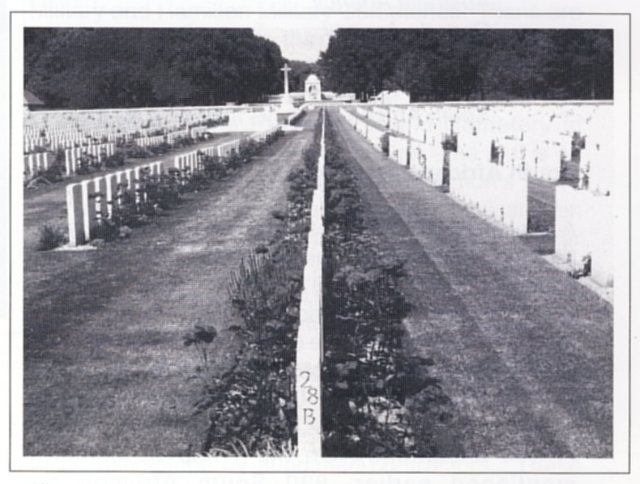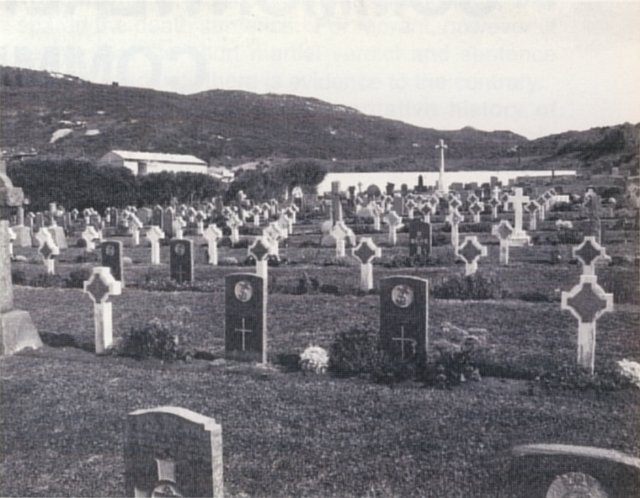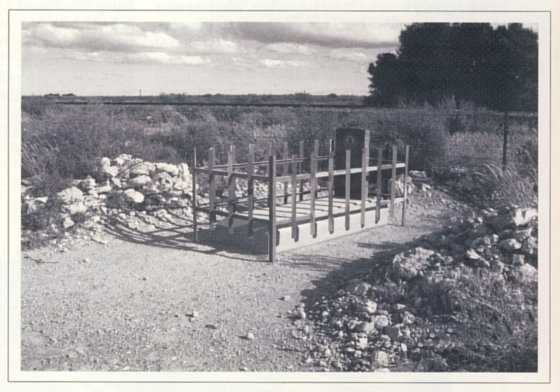

 The South African
The South African

The Delville Wood Cemetery with the South African Delville Wood Memorial and Museum in the background.
Eighty-seven South Africans are commemorated here. (Photo: C Ross).
Origin of the Commonwealth War Graves Commission
When the founder of the Commission, Sir Fabian Ware, arrived in France during September 1914 as the commander of a British Red Cross unit, he noted that there was no organisation in place to record the final resting places of casualties. Ware was concerned that, unless something was done, the graves would be lost for ever. Ware's unit took it upon themselves to register and care for all these graves. Is it possible that his earlier experience in South Africa during the South African War (Anglo-Boer War; 1899-1902) could have influenced his thinking? Both he and his wife were in South Africa during the war.
By 1915, Ware's unit was recognised by the War Office and was officially known as the Graves Registration Commission. Ware's concern over the future of the graves once the war had ended resulted in the establishment of the Imperial War Graves Commission by Royal Charter on 21 May 1917 with the following fundamental principles: Firstly, that each of the dead should be commemorated individually by name either on a headstone on the grave or by an inscription on a memorial; secondly, that headstones and memorials should be permanent; thirdly, that headstones should be uniform; and, fourthly, that there should be no distinction made on account of military or civil rank, race or creed.
At the end of the war, the work of the commission started in earnest with the construction of a number of cemeteries to accommodate the casualties. At the same time, memorials to all those who have no known grave were constructed, of which the Thiepval Memorial to the Missing of the Battle of the Somme is the most impressive. It is 45 metres high and carries over 72 000 names. Millions of plants were grown to transform the cemeteries and soften the seemingly endless rows of headstones. In addition, the Commission was faced with the challenge of manufacturing and erecting more than 500 000 headstones, each with a regimental badge or national emblem. All the South African casualties only have the Springbok head as emblem on their headstones. Many families chose not to use the Commission headstone and erected a private headstone.
The entire process was repeated during and after the Second World War. However, this time the Commission was much better prepared for the task.
Current Status
Commitment
Today the Commonwealth War Graves Commission (the name was changed in March 1960) cares for 940 000 Commonwealth burials in 2 000 constructed and 21 000 other cemeteries. In addition, more than 760 000 casualties who have no known grave are commemorated on 200 memorials. In total, the Commission cares for 1,7 million casualties across the world.
Achieving the object
To ensure that the Commission achieves its objective in respect of caring for all the graves and memorials in its care, it is divided into the following principal offices and agencies:
A total of 21 359 South Africans are commemorated by the Commission. This includes 9445 from the First World War and 11 914 from the Second World War. Outside South Africa, most South Africans, from both World Wars, are commemorated in France (3 912 casualties), Egypt (2 787 casualties), Italy (1 820 casualties), the United Kingdom (1 380 casualties), Tanzania (1 326 casualties) and Belgium (1 044 casualties). On the Thiepval Memorial mentioned earlier, 830 South Africans are commemorated, while members of the South African Labour Corps who died as a result of the sinking of the SS Mendi are commemorated on the Hollybrook Memorial in Southampton. Another 1 227 South Africans who have no known grave are commemorated on the Alamein Memorial and 172, mainly airmen, are commemorated on the Malta Memorial.
All graves and memorials are maintained by the various Area and Regional Offices of the Commission.
SOUTH AFRICAN AGENCY
Responsibility: Commonwealth War Graves
The South African Agency of the Commonwealth War Graves Commission was established in 1921 and is responsible for all First and Second World War Commonwealth war graves in the Republic of South Afrita and the Republic of Namibia. This responsibility comprises the following:
Republic of South Africa
Burial Sites. There are 602 burial sites that vary from military cemeteries (10 cemeteries), military plots within municipal cemeteries (13 plots), and scattered graves in municipal cemeteries to isolated graves on a farm or an isolated location.
Casualties. A total of 8 440 casualties are commemorated in the 602 burial sites. These comprise 2 159 from the First World War and 6 281 from the Second World War.

Dido Valley Cemetery, Simon's Town. (Photo: C Ross).
Republic of Namibia
Burial Sites. There are 32 burial sites which are mainly small cemeteries.
Casualties. A total of 427 casualties are commemorated in the 32 burial sites, largely from the First World War.
Distribution of Casualties. Included in the total Commonwealth casualties commemorated in South
Africa are the following:
| Australia | 80 casualties |
| Canada | 5 casualties |
| India | 23 casualties |
| New Zealand | 13 casualties |
| United Kingdom | 1 553 casualties |
Responsibility: South African War (1899-1902)
In accordance with an agreement signed between the Governments of South Africa and the United Kingdom, and a Memorandum of Understanding signed between the South African Heritage Resources Agency (SAHRA) and the South African Agency, the Agency was given responsibility to restore and maintain all graves and memorials of British casualties of the South African War (Anglo-Boer War) commemorated in South Africa.
Burial Sites. A total of 223 burial or commemoration sites have been identified for renovation. In accordance with a decision taken at the beginning of the project, only sites where ten or more casualties are commemorated will be renovated, unless the site is of significant historical importance. Currently two of these have been identified, a site near Frere where Winston Churchill was captured and the site where the only casualty from HMS Sybelle is buried.
Casualties. More than 24 000 casualties are commemorated in the 223 sites.
Total Responsibility
The Agency is therefore responsible for 821 sites (36 of the South African War burial sites are in the same cemetery as Commonwealth burials).
Maintaining the burial sites
High Profile Sites
Thirty of the burial sites have been identified as high profile sites where the Agency strives to meet the very stringent requirements of the Commission in respect of horticulture. This includes the ten military cemeteries and twenty other sites. As the Agency does not have its own gardening teams, contractors are appointed to maintain these sites.
The horticulture within the cemeteries is managed by the Agency's horticultural supervisor, who prepares planting schemes which are provided to the contractors to plant and maintain. The sites are visited at least twice a year. In addition, the Agency has appointed Inspectors in the Pretoria/Johannesburg/ Springs, Cape Town and Durban/Pietermaritzburg areas, who visit the sites on a monthly basis. They have a standard checklist that is ticked off on every visit and sent to the Agency. Any anomalies are then addressed with the respective contractor.
Dido Valley Cemetery in Simon's Town has just been upgraded with new plants and the erection of new sign posts, while a complete audit of all the graves has also been done. The planting of ground covers in the Military Plot of the Stellawood Cemetery in Durban continues while new plants are also being planted in the Cullinan Military, Thaba Tshwane New, Rooidam Military and Hamilton Military Cemeteries. Plans are underway to upgrade the Potchefstroom Military Cemetery.
The roses planted around the memorial in the Military Plot of the President Brand Cemetery in Bloemfontein provide a pretty picture. The plot is on the Bloemfontein Tourist Bus route. In Simon's Town, the Seafort Old Burial Ground Cemetery has just been renovated, while, in Durban, the South African War (Anglo-Boer War) plot in West Street Cemetery is being renovated. Lang's (Laing's) Nek battlefield has also been renovated, including the nine mass graves and the main memorial.
Medium Profile Sites
There are currently 74 medium profile sites which are being maintained by appointed contractors. These are all South African War (Anglo-Boer War) sites and the primary requirement is that the burial site be kept neat and tidy, ie the grass is cut regularly. The contractors are not responsible for any structural repairs, which remains the responsibility of the Agency. These contractors do, however, provide the Agency with additional eyes and ears by reporting any defects at an early stage. These sites are visited once a year.

The Seaforth Old Burial Ground, Simon's Town,
following extensive renovations. (Photo: C Ross).
Other Sites
Some of the remaining sites are within municipal cemeteries that receive some basic services, such as having the grass cut once or twice a year, while many others are isolated graves on farms or other remote places. While some of the farm burial sites are still being maintained by the farmers, many are not maintained to the same standard. The Agency has embarked on a program to have these covered with a concrete slab and, where necessary, protected with a small palisade fence. These sites are visited once every four years.
Inspections
Own Staff
The Secretary and the Horticultural Supervisor are responsible for all inspections and these are done in accordance with the yearly business plan. They are assisted by the office administrator. After each inspection, a report is submitted, indicating the status of the grave(s), condition of the cemetery/burial
ground and renovations that are required. This information is recorded on the database of the specific cemetery/burial ground.
Other Organisations
Due to the small staff and the vast area that needs to be covered, the Agency relies on other organisations and individuals such as the South African Military History Society, battlefield tour operators, exservicemen's organisations and others to pass on information about cemeteries and/or burial grounds.
Repairs
I
Own Staff
On return from an inspection tour, all information with regard to repairs needed are passed to the Technical Assistants, who then plan a repair tour to execute the required repairs.
Contractors
Certain repairs or renovations are beyond the capability of the Agency staff and contractors are then approached to execute major repairs or renovations. An example of this is the renovation of Crosses of Sacrifice in the various cemeteries.
Challenges
The Commission experiences numerous challenges around the globe, of which the following is the most prominent:
Vandalism
This is a worldwide phenomenon and cemeteries and graves are often the target of vandalism. Preventing this is by no means an easy task, as the whole idea of a well maintained military cemetery and/or memorial is to get people to visit the cemetery, so it must remain accessible. As scrap metal remains a source of income, the illegal removal of brass plaques and cast iron grave markers is a major challenge in South Africa. In the Kroonstad Old (North Road) Cemetery, more than 400 of the cast iron crosses have been removed. In the Rustenburg Cemetery, more than 50 cast iron grave markers were removed over the 2010 Easter Weekend. Fortunately graffiti is not a major challenge in South Africa. In Europe this remains a challenge and many graves and memorials have been vandalised in this matter.
CONCLUSION
Today, some 93 years since its establishment, the Commonwealth War Graves Commission remains committed to ensuring that the graves and memorials for which it is responsible are maintained to the highest standards and that the casualty database is kept up to date. The latter will soon include GPS coordinates for each cemetery.

An isolated grave of a Commonwealth casualty next to the railway line
between Britstown and Prieska. (Photo: C Ross).
Return to Journal Index OR Society's Home page
South African Military History Society / scribe@samilitaryhistory.org